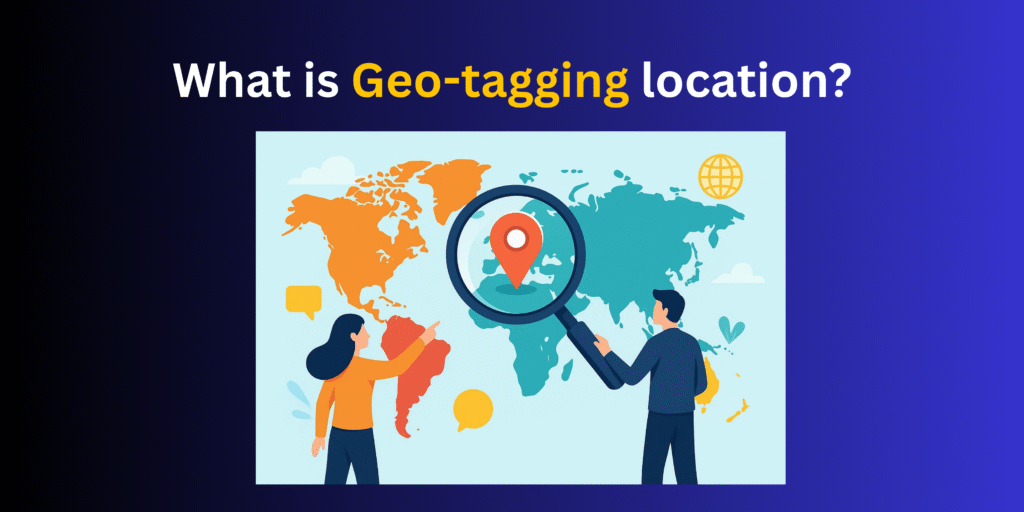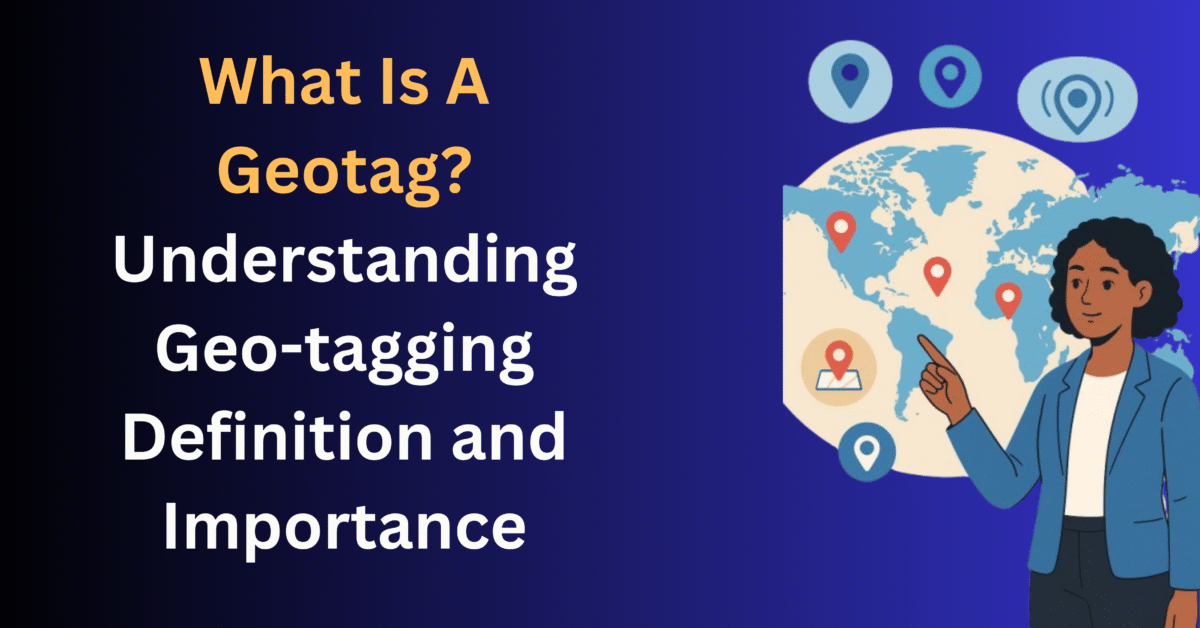What is Geotagging? Understanding Geotag Definition and Importance
The modern-day digital world finds itself inseparably linked to the real world by the magic of geotagging. An unnoticeable feature that associates with the exact area of the content, geotagging is simple, yet very impactful. Your Instagram picture of the holiday, videos on YouTube, and even a business posted on Google Maps are geotagged altogether; the geotagging is done in silence by just putting along the ‘where’ behind every online event. In today’s world, geotagging is no longer limited to travelers or photographers; it has become an important part of marketing, data analytics, and online participation, which in turn provides richer and more connected digital footprints with the physical world.
What Is Geotagging and How Does It Work?
Geotagging Definition in Simple Terms
It is the technique of attaching location data such as latitude and longitude to digital content like photos, videos, and social media posts.
To put it simply, geotagging allows your digital activity to be linked to a particular place on earth. For instance, when you upload a picture with the tag “Gateway of India, Mumbai,” the tag is more than just a word; it has underlying metadata that shows your precise place on earth through GPS.
This technology has become ubiquitous since it is incorporated in almost all, if not all, smartphones and digital cameras making it easy and automatic to tag your location.
Geo Tag Full Form and How It’s Used
The full form of geo tag is Geographical Tagging. As the name implies, it links geographical information (like the city, address, or GPS coordinates) with your digital files. Geotagging functions as a digital bridge between the physical realm and online content, enabling both users and businesses to know where an image, video, or post came from.
For example:
- A food blogger can geotag restaurant photos for better visibility.
- A brand can tag its retail outlet photos on Google for local SEO benefits.
- A traveler can revisit their journey map through automatically geotagged pictures.
Thus, geo tagging location data adds context and depth to the digital content we consume daily.
How Geotagging Works Technically
Geotagging is performed with the help of GPS (Global Positioning System), mobile data, Wi-Fi signals, and device sensors.
Capture a photo, and your gadget does the job of collecting the latitude, longitude, altitude, and even direction through these sensors, and stores them in the EXIF metadata (Exchangeable Image File Format) of the derived file.
Here’s a simple breakdown:
- GPS and Location Services – Determine your precise coordinates.
- Timestamp and Device Info – Add date, time, and device model.
- EXIF Metadata Storage – Embeds the location and technical details within the photo or video file.
This process creates a geo-tagging location record, which can later be used for mapping, organizing, or marketing purposes.
Also Read: Google My Business: How Local SEO Grows Your Brand
What Is a Geo-Tagged Photo?
Geotagged Photos Meaning
A geo-tagged photo, on the other hand, is an image that not only shows the location but also has the information about the location, such as where it was taken, attached to its metadata.
When you open a photo like that in Google Photos or Apple Photos, sometimes a little map that indicates where the photo was taken might appear. That’s an example of geotagging being used.
Simply put, the term geotagged photos refers to computer-generated pictures that retain the GPS coordinates that link them to the earth’s surface.
Benefits of Geotagged Photos for Users and Businesses
Geotagged photos have a wide range of advantages:
For users:
- Automatically organize images by location.
- Create interactive travel maps.
- Recall memories with contextual details.
For businesses:
- Boost local SEO by tagging store or event photos.
- Geo Targeting Ads improve visibility for small businesses.
- Improve Google My Business listings with location-verified content.
- Help customers find physical stores through online geotag tools.
Using online geotag editors like GeoImgr or MetaGPS, anyone can easily add or modify location information on images to make them more searchable and accurate.
How to Check If Your Photos Are Geotagged
Here’s how you can verify if your photos contain location data:
On Android:
- Open the photo in the Gallery app.
- Tap the three-dot menu → “Details” or “Info.”
- Look for location or map coordinates.
On iPhone:
- Open the Photos app → Tap the photo.
- Swipe up to see the map or “Place” section.
On Desktop (Windows/Mac):
- Right-click the photo → Select “Properties” → “Details.”
- Under GPS or Location, check if coordinates are listed.
Online Check:
- Upload to an online geotag tool like GeoImgr.com.
- It will show the exact location data embedded in your image.
Importance of Geotagging in the Digital World
Why Geotagging Matters for Businesses
In digital marketing, on the other hand, geotagging is one of the main factors that determine local SEO and location-based visibility.
By using geo tagging location data in photos and posts, businesses improve their chances to appear in relevant local searches.
Example:
A café in Delhi that uploads geotagged images to its Google My Business profile is more likely to appear when someone searches “best café near me.”
This simple step can:
- Increase organic visibility.
- Attract nearby customers.
- Strengthen brand credibility with verified locations.

Moreover, platforms like Instagram and Facebook allow users to search by tagged locations — offering an additional channel for discovery.
Geotagging and Data Privacy
On the other hand, geotagging, though helpful, comes with some privacy concerns.
Once geotags are made public, they can, unfortunately, point out your exact location which in turn could raise safety issues — especially for kids, adults, and the like.
To stay safe:
- Turn off location tagging for sensitive photos.
- Review app permissions regularly.
- Remove geotags before sharing personal content.
Knowing how to manage and control geotagged photos meaning is key to enjoying the benefits of this technology responsibly.
How to Add or Remove Geotags from Photos
Adding Geotags with Online Tools
If your images don’t contain location data, you can add it easily using online geotag tools such as:
- GeoImgr.com – Upload a photo → Select location on map → Save new version.
- MetaGPS – Batch-edit geotags for multiple photos at once.
- ExifFixer – Add or correct GPS coordinates from a simple interface.
These tools are particularly useful for photographers, real estate agents, and marketers who want to optimize their images for local search and digital campaigns.
Removing or Editing Geotags for Privacy
To maintain privacy, it’s wise to review or delete location data before sharing photos online.
On Android:
- Open the photo → Tap Details → Edit → Remove location.
On iPhone:
- Before sharing → Tap Options → Turn off Location.
On Desktop:
- Right-click image → Properties → Details → Remove Properties and Personal Information.
Editing or clearing geotags ensures your location remains private — especially before uploading personal content. Always understand geotagged photos meaning before making them public.
Future of Geotagging Technology
The future of geotagging is intertwined with cutting-edge technologies like AI (Artificial Intelligence) and AR (Augmented Reality).
Emerging trends include:
- AI-based Smart Tagging – Automatically suggesting tags based on location and activity.
- Augmented Reality Mapping – Overlaying real-time geotags on AR interfaces for navigation and tourism.
- Location-Based Marketing – Delivering targeted ads and personalized offers based on user proximity.
As these technologies evolve, geotagging will continue to redefine how we experience, share, and market information across digital landscapes.
Conclusion
The process of geotagging draws a nice line between the digital and the physical worlds by means of location data that is precise. It has become an important part of our online ecosystem, from travelers being able to indulge in their past trips to businesses getting boost in local SEO.
Might you be a photographer, a marketer, or a casual smartphone user, it is the understanding of geotagging that will allow you to use digital tools more efficiently — visibility and privacy being the two sides of the same coin.
At Metaloop, the brands are being given a helping hand to feature technology such as geotagging and the latest digital marketing innovations in visibility and customer engagement — thereby setting new standards in smart marketing strategies.
FAQs About Geotagging
- What is the main purpose of geotagging?
The main purpose of geotagging is to associate digital content with a real-world location. It helps organize, locate, and share photos or posts accurately and improves visibility for businesses through location-based marketing.
- How do I view geotag information in photos?
You can check photo details through your phone’s gallery info or desktop properties tab. Many photo apps also show a small map preview of where the image was taken.
- What is the full form of geo tag?
The full form of geo tag is Geographical Tagging, which means linking digital files like photos or videos with specific GPS coordinates.
- Are geotagged photos safe to share online?
Geotagged photos can reveal exact locations, so it’s best to review or remove tags before sharing publicly — especially for personal or home-based photos.
- How does geotagging help in digital marketing?
Geotagging boosts local SEO by allowing businesses to appear in nearby searches. It enhances brand authenticity, improves Google visibility, and connects customers to real-world store locations.



Write a Comment